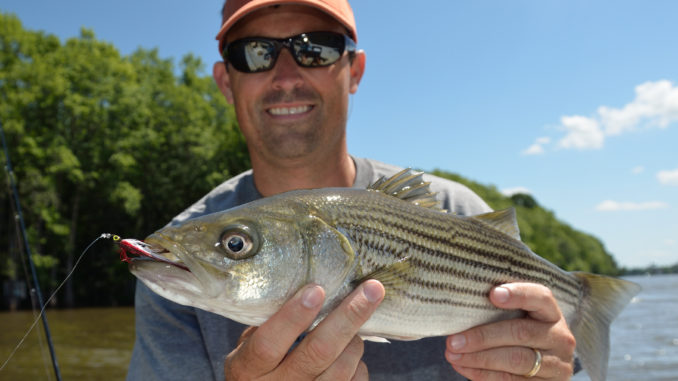
Fish returning to lower Roanoke River with big appetites
During the spring, the tiny town of Weldon at the head of the Roanoke River gets blasted with hundreds of thousands of spawning stripers every year and their fair share of anglers. The spawning run is famed as one of the biggest striper success stories in the country and for good reason.
But as water temperatures rise, those fish leave their spawning grounds and head downstream towards their summer quarters in the Albemarle Sound. While the Weldon action may have ended in May, the striper fury is on again in the river’s lower reaches.
From Williamston to Edenton Bay, the Roanoke is flooded with returning stripers – but few people around to catch them. Capt. Mitch Blake of FishIBX.com (252-495-1803) is one of them; he anticipates the return of these fish to his home waters near Jamesville each year. According to Blake, the fish have arrived and are eating with a vengeance.
“They are thick and crushing flies – Clousers, Deceivers, you name it – the fishing is incredible, with 100-fish days on the fly,” he said.
While some fish are coming to the top and hammering poppers, the majority are found in the lower third of the water column between 20 and 28 feet. He is using full sinking line (200 to 300 grains), and he allows the flies to sink near the bottom or where the fish are suspended before he begins to make short, quick strips.
His hot flies right now are actually “hot” patterns, such as: electric chicken (or tutti-frutti), chartreuse, chartreuse/white and red/white. He prefers flies 2 to 3 inches long, but since the fish are so active, a variety of other colors, sizes and patterns can be effective.
“The best action is between mid-morning thorough the afternoon,” Blake said. “The fish will be on the bottom in the morning and will (rise) to the mid- to upper section of the water column as the sun rises higher in the sky.”
While the river is full of fish, they are migrating downstream using the channel as their path. Blake finds fish holding on irregularities along the bottom by using his Humminbird Down Imaging Sonar.
“The river has places where sunken logs and trees accumulate near changes in depths,” he said. “These fish will stop at these places and feed for a few days before passing downstream to the next one.”
The lower Roanoke is just another staging area for these fish on their annual migration cycle. In a few more weeks, the last few schools will pass through the river and reach their summering grounds in the Albemarle Sound. Blake said the fish will be available in the lower river until the water temperatures warms past 76 to 78 degrees. Until then, bring your fly rod, a handful of flies, and hit the river before it’s too late!




Be the first to comment